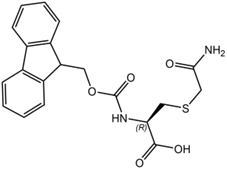Welcome to Iris Biotech
For better service please confirm your country and language we detected.

For better service please confirm your country and language we detected.

Thank you very much for your interest in our products. All prices listed on our website are ex-works, Germany, and may attract customs duties when imported.
You may/will be contacted by the shipping company for additional documentation that may be required by the US Customs for clearance.
We offer you the convenience of buying through a local partner, Peptide Solutions LLC who can import the shipment as well as prepay the customs duties and brokerage on your behalf and provide the convenience of a domestic sale.
Continue to Iris Biotech GmbHSend request to US distributorPublished on 13.06.2023

Already a century ago, long before having clear insight into enzymatic mechanisms, it was discovered that haloacetic acids have “toxic” effects on metabolic pathways and physiological functions. In the early 1930s it was identified that this “iodoacetate poisoning” was caused by reaction of the haloacetic acid with thiols, probably in Cysteines. Soon it could be shown that the nucleophilic substitution of the iodoacetate’s halogen by Cysteine’s sulfur lead to a covalent carboxymethylation of the Cysteine side chain, “Cys(Cm)”. Since then, the inactivation of enzymes with Iodoacetate was the method of choice for decades to prove that a free Cysteine side chain is involved in an enzymatic reaction.
Later, this modification was also used to elucidate the role of disulfide bridges in protein folding, protein stability, or covalent complex formation. After reductive cleavage of disulfide bridges, the now free Cysteine side chains were then alkylated permanently with iodoacetate to prevent re-oxidation to disulfide bridges. However, carboxymethylation leads to negative charging of the Cysteine side chain by the acetate group, resulting in electrostatic repulsion of the former disulfide bridging partners. This can be avoided by using iodoacetamide instead. The resulting carboxamidomethylated Cysteine “Cys(Cam)” is uncharged and thus no electrostatic effects may confound the investigations.

Schematic representation of a peptide with a disulfide bridge (left), with reduced and carboxymethylated Cysteines “Cys(Cm)” leading to electrostatic repulsion (center), and with reduced and carboxamidomethylated Cysteines “Cys(Cam)” (right).
This Cys(Cam) is also frequently used in procedures for sequencing, identifying, or quantifying proteins by MS analysis: before cleaving a longer protein into peptide fragments by a protease (typically trypsin), the protein’s Cysteines are reduced and modified by iodoacetamide to ensure linear, non-bridged peptide fragments.
Typically, MS analyses of the tryptic digestion products are calibrated by spiking the samples with a known quantity of a synthetic peptide standard. Originally, the SPPS standards were synthesized using Cys(Mmt) with subsequent deprotection followed by carboxamidomethylation with iodoacetamide. However, this approach leads to undesired side products or incomplete modification.
Our building block Fmoc-L-Cys(Cam)-OH (FAA9090) circumvents this problematic strategy. It is stable to TFA and standard Fmoc-SPPS conditions and yields directly the desired Cys(Cam) containing peptide without further modification requirements.

Chemical structure of Fmoc-L-Cys(Cam)-OH (FAA9090) provided by Iris Biotech.
→ For more interesting Cysteine building blocks, please click here or download our brochure Cyclic Peptides
References:
Interaction of halogenacetates and SH compounds: The reaction of halogenacetic acids with glutathione and cysteine. The mechanism of iodoacetate poisoning of glyoxalase; F. Dickens; Biochemical Journal 1933; 27: 1141-1151. https://doi.org/10.1042/bj0271141
The reaction of iodoacetate and of iodoacetamide with various sulfhydryl groups, with urease, and with yeast preparations; C. V. Smythe; Journal of Biological Chemistry 1936; 114: 601-612. https://doi.org/10.1016/S0021-9258(18)74789-3
The absolute quantification strategy: a general procedure for the quantification of proteins and post-translational modifications; D. S. Kirkpatrick, S. A. Gerber, S. P. Gygi; Methods 2005; 35: 265-273. https://doi.org/https://doi.org/10.1016/j.ymeth.2004.08.018
Lysine-Targeting Reversible Covalent Inhibitors with Long Residence Time; R. M. Reja, W. Wang, Y. Lyu, F. Haeffner, J. Gao; Journal of the American Chemical Society 2022; 144: 1152-1157. https://doi.org/10.1021/jacs.1c12702